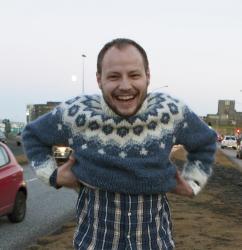Literary fame is a finicky kind of fame. A writer can have raving reviews in the New York Times, The Guardian, The New Yorker, and more; she can win slews of major literary honors, and teach at big name universities, and yet you might still be left scratching your head after hearing about ‘Autobiography of Red’ and ‘Red Doc>,’ the best-known of her 20+ books. In other words, you’d be forgiven for missing this literary star’s recent string of performances in Reykjavík.
Beside the litany of her CV, her oeuvre stretches from ancient Greek translation to history to poetry to prose to bookbinding to performance art, with most pieces blending at least two of these mediums. This wasn’t her first reading in Iceland—she did a residency at Vatnasafnið, “The Library of Water,” in Stykkishólmur in 2008. During that residency, she wrote “Cage a Swallow Can’t You But You Can’t Swallow a Cage,” which was later scored by Kjartan Sveinsson of Sigur Rós. (Listen here.)

Whether by accident or design, she returned to Reykjavík ten years later for the release of her newest book. Titled ‘Vör/Lip: A Mean Sonnet Sequence,’ it’s a bilingual collaboration between herself, artist Bob Currie, and translator Ingibjörg Sigurjónsdóttir. In addition to this new release, she also held two readings of other works at Mengi, turning this particular weekend into something of a mini-Anne Carson festival.
Red thread
With every copy sold before the reading could begin, the book release was buzzing. The room was packed full, with more people crowded near the door in the foyer trying to listen. She typically reads to packed auditoriums, but the museum seemed like a better place for her work. Surrounded by the sculptures of Einar Jónsson, the event was partly classical, partly modern, and entirely surreal.
To put it simply, ‘Vör/Lip’ is about sewing one’s own lips together. She was deeply affected, she explained, by reading about this act of utter desperation by refugees and political prisoners during hunger strike. The sonnets are in prose verse in English and Icelandic, punctuated with rug designs by Bob Currie. As the reading progressed, Bob zigzagged slowly through the crowd from one end of the room to the other. He trailed a red string as he went, sewing the room together. The anguish of the theme bled quietly out the edges of her characteristic delivery, as terse as some of the book’s curtest lines: “Lick / / it / up, / Daddio, / death / is / dry.”

Cut to meaning
The following night at Mengi, the evening was opened by national treasure Sjón and Icelandic translations of Emily Dickinson’s poems by Magnús Sigurðsson. Anne performed “Cassandra Float Can” from her 2016 collection ‘Float.’ The text describes the sensation of translation as veils floating up, revealing. It blends etymology and a lesson on “anarchitecture” with Cassandra from ‘Agamemnon,’ who stands silently on stage throughout the entire play until she is asked, “What’s the matter, don’t you speak Greek?”
When she replies with a shout of metrically perfect nonsense and a prophesy, the text asks, “What is the future doing underneath the past or Greek metrics inside a Trojan silence and how does it alter you to see it there floating and how can it float?” Throughout the performance, a team of people walked through the audience holding up canvas sheets with photos printed on them, obscuring visuals, creating others, and adding literal and metaphorical layers to the idea of cutting through something to find meaning.
Time and spaces
Her final performance was sandwiched between Ásta Fanney’s naturalist musings and a reading by Ragnar Helgi about—amongst other things—birds, birdwatching, and the importance of a good jacket to a poet. Anne performed “Uncle Falling,” a lyrical biography of her family, her uncle, and his process of aging. It illuminates the thin ties between time and reason, asking, “How light, how loose, how unprepared and unpreparable is the web of connections between any thought and any thought.” The reading was accompanied by a disruptive, contradictory “panel of Gertrude Steins” and two people folding sheets onstage. One group was busily breaking connections and the other remaking them.

To listen to Anne Carson read is to be mesmerised by your own uncertainty, the possibility of misunderstanding. One reading is enough to make you question your own existence, but three days back to back is enough to leave you questioning language, reason, and the space-time continuum itself. Could she be an actual ancient Greek poet, thrown forward through time like a harpoon into our rough century?
Her presence is simultaneously natural and unnatural, like watching a bird collecting seemingly random leaves and plastic bottle caps. Only if you follow it to the end can you see how each piece fits into the structure of its nest. There isn’t a piece missing; every space is intentional. That’s where the meaning is.
Info: Anne Carson read at Mengi on June 29th & 30th
Buy subscriptions, t-shirts and more from our shop right here!







































